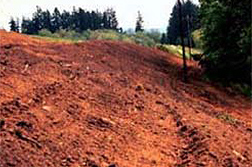This page has been archived and is being provided for reference purposes only. The page is no longer being updated, and therefore, links on the page may be invalid.
| Read the magazine story to find out more. |
 ARS microbiologist Pat Millner is developing a way to cap or seal old landfills with more environmentally sensitive vegetative caps—trees and shrubs planted in a mix of topsoil and compost—in place of conventional clay caps. |
|
|
A Green Way to Cap an Old Landfill
By Don ComisFebruary 9, 2011
U.S. Department of Agriculture (USDA) scientist Pat Millner and safety manager David Prevar have worked with the U.S. Environmental Protection Agency (EPA) and private consultants to design and conduct a pilot study for an alternative way to cap landfills.
Millner is a microbiologist at the 6,615-acre Henry A. Wallace Beltsville Agricultural Research Center (BARC) operated in Beltsville, Md., by the Agricultural Research Service (ARS), the chief intramural scientific research agency of USDA.
Prevar oversees safety and health issues for the ARS Beltsville Area, which, in addition to BARC, consists of the agency's programs at the U.S. National Arboretum in Washington D.C, and worksites in Chatsworth, N.J.; Presque Isle, Maine; and McMinnville, Tenn. BARC is the largest and most diversified agricultural research complex in the world.
The pilot project is on part of a long-abandoned, 30-acre municipal landfill located at BARC.
Millner's idea was to cap or seal the old landfill with trees and shrubs, planted in a mix of topsoil and compost, instead of the traditional clay caps. Vegetative caps are gaining acceptance from state agencies as a sustainable practice. EPA Region 3, which serves the Mid-Atlantic states, sees the BARC project as a potential model.
Vegetative caps reduce methane emissions while preventing rainfall from penetrating into the municipal waste and then leaching into groundwater. Also, an increase in forest canopy contributes to improving the health of the Chesapeake Bay by sequestering carbon and filtering runoff. BARC's waterways drain into tributaries of the Bay.
The Maryland Department of the Environment has been following this project closely, since there are numerous landfills statewide that would benefit from this alternative closure approach. This method of capping is more environmentally sound and economical. If accepted by Maryland, when fully implemented it would create more than 30 acres of forest canopy and critical habitat.
The project is described in the poster "An innovative Approach to Landfill Capping - A Joint Environmental Unit & Research Project at the College Park Landfill." Click here and scroll to the bottom of the page to view the poster.
Read more about this research in the February 2011 issue of Agricultural Research magazine.

